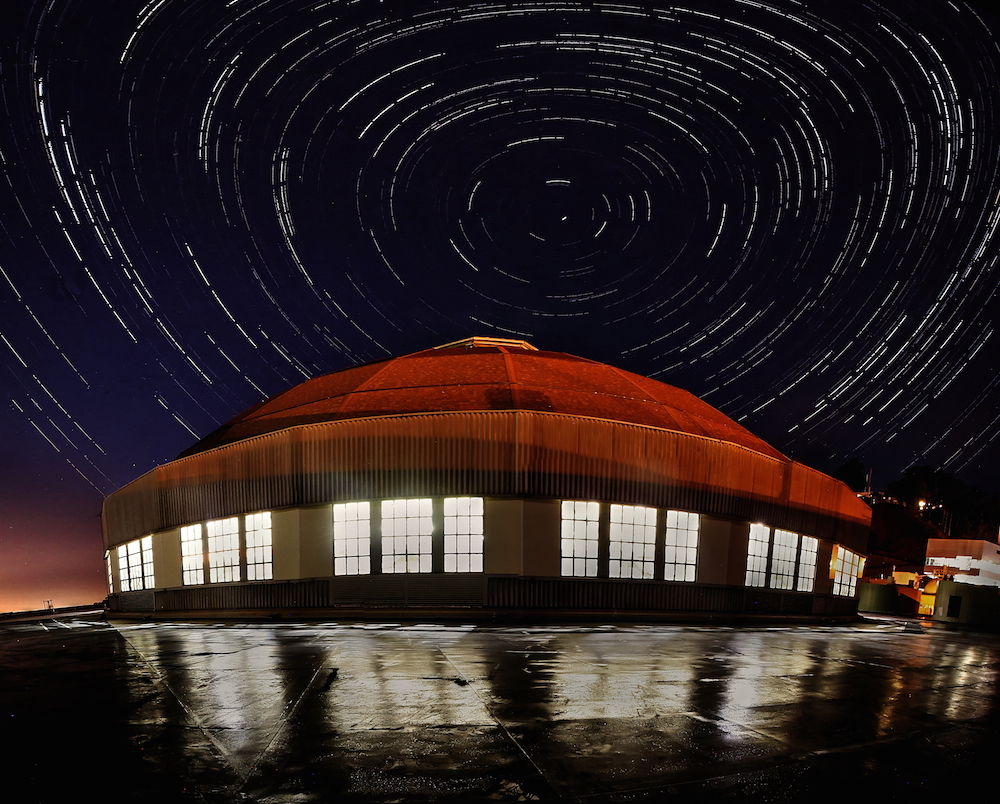
A time-lapse view of the Advanced Light Source building at night. (Credit: Haris Mahic/Berkeley Lab)
The U.S. Department of Energy (DOE) has confirmed the need for a unique source of X-ray light that would produce beams up to 1,000 times brighter than are now possible at Lawrence Berkeley National Laboratory’s (Berkeley Lab) Advanced Light Source (ALS), enabling new explorations of chemical reactions, battery performance, biological processes and exotic materials.
The proposed Advanced Light Source Upgrade project, also known as ALS-U, has cleared the first step in the DOE approval process. On Sept. 27 it received “critical decision zero,” also known as CD-0, which approves the scientific need for the project. This initial step sets in motion a process of additional planning and reviews, and the laboratory will begin the upgrade’s conceptual design.
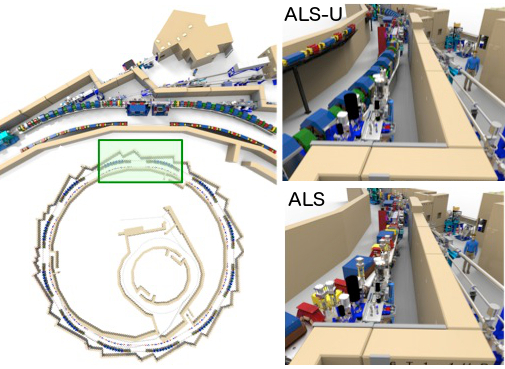
This rendering shows the existing equipment at Berkeley Lab’s Advanced Light Source (lower right) that forms the storage ring where accelerated electrons give off energy in the form of light. A planned upgrade, ALS-U (left and upper right), would replace this storage ring with a denser array of magnets, known as an MBA lattice, that would produce far brighter, steadier beams of so-called “soft” X-ray light. A unique secondary ring along the ALS’s inner wall, called an “accumulator” ring, would rapidly replenish the energy in the main ring. (Credit: Berkeley Lab)
If ultimately advanced, the ALS-U would feature a new, circular array of powerful, compact magnets. This state-of-the-art array, known as a “multibend achromat (MBA) lattice,” and other improvements would allow the ALS to achieve far brighter, steadier beams of so-called “soft” or low-energy X-ray light to probe matter with unprecedented detail.
MBA systems have been demonstrated successfully at a light source in Sweden known as MAX IV, and will be put to use in a planned upgrade to Argonne National Laboratory’s Advanced Photon Source facility in Illinois that specializes in a range of energies known as “hard” X-ray light that is complementary to the separate range of X-ray energies produced at the ALS.
“This upgrade project is a very high priority for the laboratory and builds upon the lab’s long legacy of building and operating particle accelerators,” said Berkeley Lab Director Michael Witherell. “The ALS-U project will benefit from our expertise in many disciplines here, from engineering to accelerator and beam physics, and computer modeling and simulation.”
Dave Robin, who is leading the ALS-U effort, said, “We’re excited by this development. ALS-U is designed to be the world’s brightest soft X-ray synchrotron light source. It will enable a generational leap, surpassing any soft X-ray storage-ring-based light source operating, under construction, or planned.”
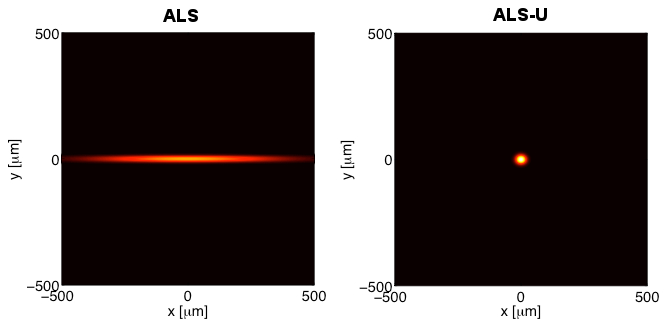
The electron beam profile of Berkeley Lab’s Advanced Light Source today (left), compared to the brighter, highly focused beam (right) that is possible with an upgrade known as ALS-U. (Credit: Berkeley Lab)
The present-day ALS is already a premier destination for thousands of scientists from around the nation and world each year to conduct soft X-ray experiments. Soft X-rays are particularly suited to studies of chemical, electronic, and magnetic properties of materials. The upgrade would deliver light to experiments in nearly continuous waves that are more uniform, or highly “coherent” and laser-like, which would allow scientists to resolve nanoscale properties in a range of samples and to observe real-time chemical processes and material functions.
“ALS now is the world leader in science that utilizes soft X-rays. ALS-U will allow us to continue to lead the world in measuring and understanding new materials and chemical systems for the 21st century,” said Roger Falcone, ALS director. “With this brighter source, we can move from where we take high-resolution static images to making movies. We can look at things in finer detail and see how they are functioning in real time.”
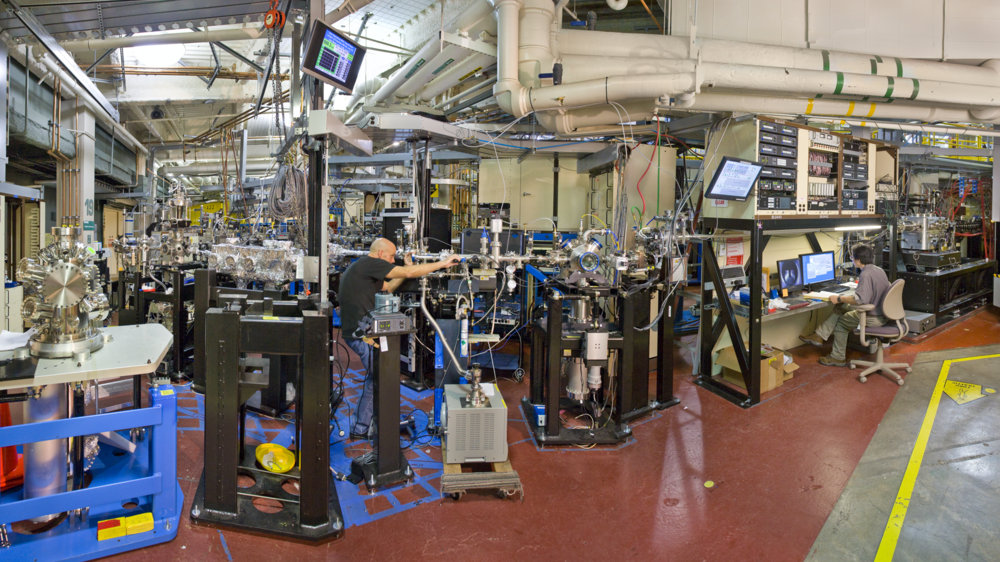
The MERLIN X-ray beamline at Berkeley Lab’s Advanced Light Source, pictured here, specializes in studies of electronic structure in materials with exotic electronic and magnetic properties. (Credit: Roy Kaltschmidt/Berkeley Lab)
In particular, the brighter, more coherent beams, which would approach the fundamental limits in performance for soft X-rays, will be useful for exploring materials at the nanoscale to map out their physical, chemical, and electronic structure as they evolve. Modern materials are complex and inherently varied, so their functionality can only be understood by measuring this non-uniformity in their properties.
Scientists could use these beams to produce 3-D maps of battery and fuel cell chemistry at work, for example, which could ultimately provide clues to improving their performance.
The brighter, more coherent, beams could also be used to explore exotic materials phenomena like superconductivity, in which materials can carry electrical current with nearly zero loss; and to study unusual quantum properties that are poorly understood and defy explanation by classical physics.
The ALS is a synchrotron light source that can produce a wide spectrum of light, from infrared and ultraviolet light to X-rays. Synchrotrons accelerate electrons to nearly the speed of light, then direct them into curving paths that cause the electrons to give off some energy in the form of photons—fundamental particles of light. The electron storage ring at ALS is approximately 200 meters in circumference.
ALS-U would utilize and preserve the existing ALS building, an iconic domed structure designed in the 1930s by Arthur Brown Jr., the architect who also designed Coit Tower, a San Francisco landmark.
The upgrade would incorporate most of the 40 beamlines and supporting equipment that now allow simultaneous experiments across a wide range of scientific disciplines. Also, three new beamlines are planned that will be optimized for the new capabilities of ALS-U.

A panoramic view of the interior of the Advanced Light Source. (Credit: Roy Kaltschmidt/Berkeley Lab)
About 200 scientific and engineering staff work at the ALS, which draws thousands of scientist “users” per year from around the world. In fiscal year 2015, the ALS hosted more than 2,500 of these visiting scientists from 43 U.S. states and Washington, D.C., and 33 other nations. In collaboration with ALS staff experts, these scientists produce more than 900 peer-reviewed articles per year featuring work performed at the ALS.
“For over 20 years the ALS has grown in its number of users and the breadth of publications,” Falcone said. “This upgrade will ensure that in the next 20 years we will continue on that growth path, serving even more scientists and doing more science at emerging frontiers.”
The ALS dome was originally built in the 1940s to house an early particle accelerator known as the 184-inch cyclotron, a brainchild of Berkeley Lab founder Ernest O. Lawrence. Construction to convert the facility into the ALS began in 1988 and was completed in 1993. The ALS has undergone several improvements since startup—the latest was a four-year brightness improvement project, completed in 2013 and which recently received the Energy Secretary’s Achievement Award, that as much as tripled the brightness of X-ray light at some of its beamlines.
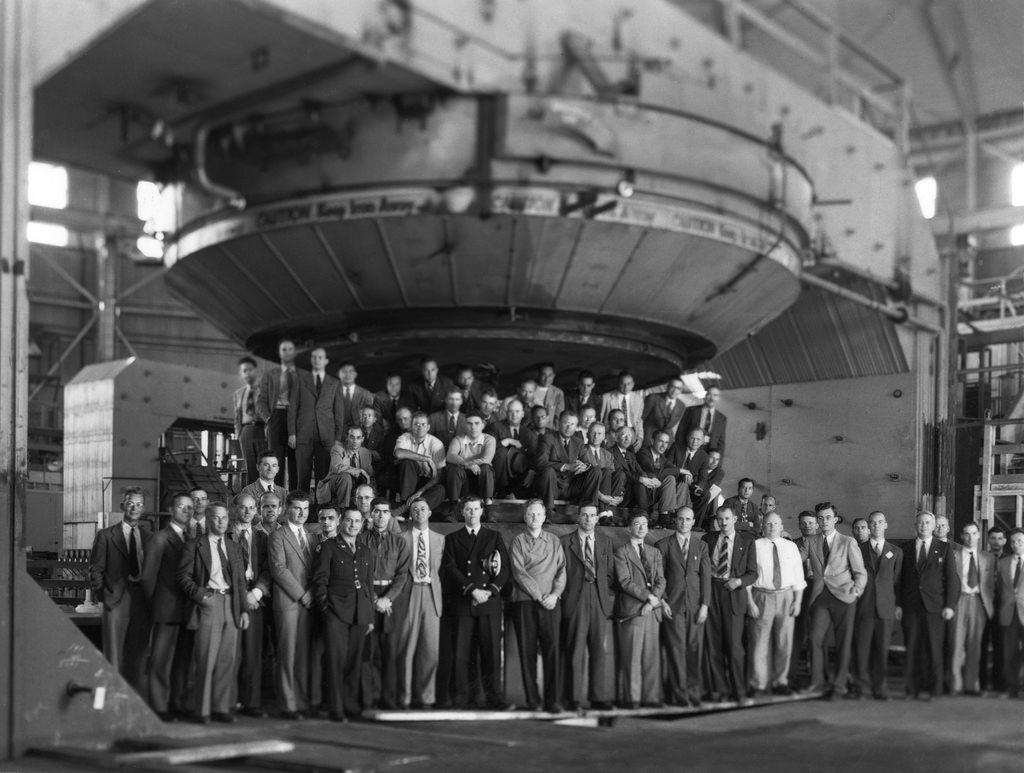
Ernest O. Lawrence and staff posed with the large magnet at the 184-inch cyclotron, also known as a synchrocyclotron, completed in 1946. Berkeley Lab’s Advanced Light Source is now located in the building that housed the synchrocyclotron. (Credit: Berkeley Lab)
ALS-U represents the largest new project at the lab since the ALS was completed, and takes advantage of a more than half-billion-dollar investment in the existing ALS, said Robin. ALS-U could conceivably be up and running within a decade, he added. The next stage of DOE project review and approval, known as CD-1, would confirm site selection for the proposed transformational soft-X-ray synchrotron project.
The Advanced Light Source is a DOE Office of Science User Facility.
For more information about the ALS-U project, visit: http://als.lbl.gov/als-u/overview.
###
Lawrence Berkeley National Laboratory addresses the world’s most urgent scientific challenges by advancing sustainable energy, protecting human health, creating new materials, and revealing the origin and fate of the universe. Founded in 1931, Berkeley Lab’s scientific expertise has been recognized with 13 Nobel prizes. The University of California manages Berkeley Lab for the U.S. Department of Energy’s Office of Science. For more, visit www.lbl.gov.
DOE’s Office of Science is the single largest supporter of basic research in the physical sciences in the United States, and is working to address some of the most pressing challenges of our time. For more information, please visit science.energy.gov.